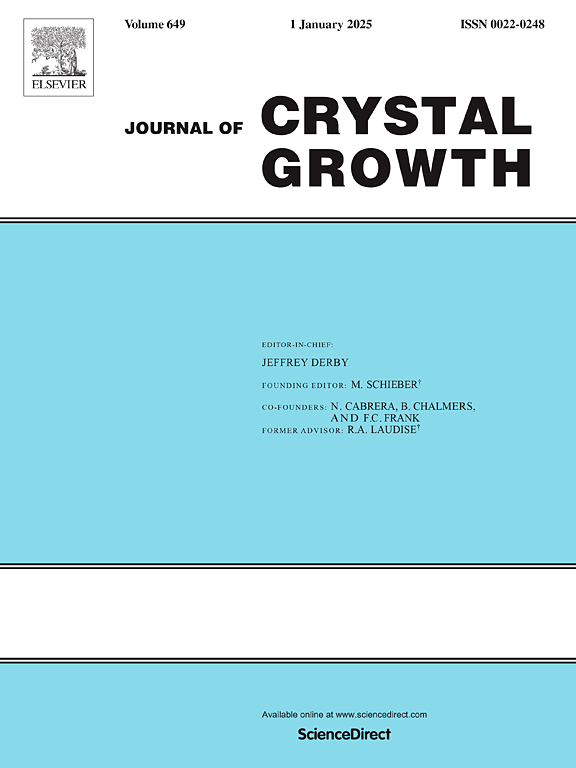基于环形粉末结构的SiC厚晶的数值模拟
IF 1.7
4区 材料科学
Q3 CRYSTALLOGRAPHY
引用次数: 0
摘要
碳化硅(SiC)在功率器件和射频器件中具有重要的应用前景。然而,昂贵的SiC衬底是限制器件成本的关键因素。发展大直径厚SiC晶体生长技术有望降低SiC衬底成本。目前,SiC晶体生长中存在厚度有限、热应力升高、缺陷密度高等问题。基于仿真工具,分析了粉末粒度和粉末表面距离对热场、晶体厚度和位错密度的影响。然后,提出了一种环形粉末结构,以提高晶体的生长速度和质量。内环和外环粉末尺寸分别为500 μm和10000 μm时,可以获得均匀的温度场、快速的晶体生长速度和较低的位错密度。此外,通过优化绝缘结构,晶体表面微凸,位错密度较低。结果表明,环形粉末结构能提高粉末的利用率,促进厚晶的生长,降低位错密度。本文章由计算机程序翻译,如有差异,请以英文原文为准。
Numerical simulation of thick SiC crystal based on ring-shaped powder structure
Silicon carbide (SiC) has important application prospects in power and radio frequency (RF) devices. However, the expensive SiC substrate is a key factor restricting the cost of the devices. Developing large-diameter and thick SiC crystal growth technology is expected to reduce the cost of SiC substrate. Currently, challenges such as limited thickness, elevated thermal stress, and high defect density remain in SiC crystal growth. Based on simulation tools, the effect of the powder size and the distance between the seed and powders surface on thermal field, crystal thickness and dislocation density are analysed. Then, a ring-shaped powder structure is proposed to enhance both the growth rate and the quality of the crystal. Simulations with different powder sizes in the inner circle and outer ring reveal that when the powder sizes are 500 μm in the inner circle and 10,000 μm in the outer ring, a uniform temperature field, a rapid crystal growth rate, and a low dislocation density can be achieved. Additionally, by optimizing the insulation structure, the crystal achieves a slightly convex surface and a lower dislocation density. The results indicate that the ring-shaped powder structure can enhance powder utilization, enable the growth of thick crystals, and reduce dislocation density.
求助全文
通过发布文献求助,成功后即可免费获取论文全文。
去求助
来源期刊

Journal of Crystal Growth
化学-晶体学
CiteScore
3.60
自引率
11.10%
发文量
373
审稿时长
65 days
期刊介绍:
The journal offers a common reference and publication source for workers engaged in research on the experimental and theoretical aspects of crystal growth and its applications, e.g. in devices. Experimental and theoretical contributions are published in the following fields: theory of nucleation and growth, molecular kinetics and transport phenomena, crystallization in viscous media such as polymers and glasses; crystal growth of metals, minerals, semiconductors, superconductors, magnetics, inorganic, organic and biological substances in bulk or as thin films; molecular beam epitaxy, chemical vapor deposition, growth of III-V and II-VI and other semiconductors; characterization of single crystals by physical and chemical methods; apparatus, instrumentation and techniques for crystal growth, and purification methods; multilayer heterostructures and their characterisation with an emphasis on crystal growth and epitaxial aspects of electronic materials. A special feature of the journal is the periodic inclusion of proceedings of symposia and conferences on relevant aspects of crystal growth.
 求助内容:
求助内容: 应助结果提醒方式:
应助结果提醒方式:


